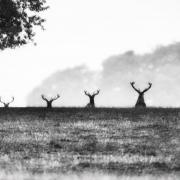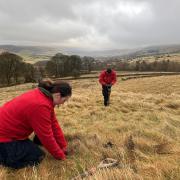Andrew Griffiths heads to Duffield and learns how, thanks to a Wild Trout Trust-led project, salmon and other migratory fish will once again reach their historic breeding grounds
We’d just turned off the Duffield-to-Wirksworth road onto a small lane. A sign at the top had warned us that it was for light traffic, walkers and bikes only. This sounded promising.
I was looking for a good view of the River Ecclesbourne, a small stream that rises in Wirksworth, flows down its valley and enters the River Derwent at Duffield.
We’d parked over the first bridge we crossed - it was going to be either the river or the heritage railway line, where the vintage trains track the water along the beautiful Ecclesbourne valley.
Leaning over the old stone bridge I felt a pleasing cool draught on this hot summer’s day, then the tingling anticipation that only the air around a river can produce.
Peering down between the leaves of the tree cover, my eyes adjusting to this suddenly darker world, I’d found the shadow waters of the Ecclesbourne.
Here, above Duffield, flowing through the valley, this is only a small stream. In the relative cool of the shade, between the boulders, these gravels should provide a perfect breeding ground for trout and the salmon that are increasingly returning to the River Derwent to spawn in autumn, and for the subsequent fry and juvenile fish to live out the first few years of their lives before beginning their own, distant sojourn at sea.

But there has been no salmon here, nor other migratory fish, for many a long year, because the door to this stream has been slammed firmly shut by a large, concrete weir built in the 1970s near the mouth of the river at Duffield.
Over the summer of 2022 this all changed. In a project led by river conservation charity the Wild Trout Trust and funded by the Environment Agency, the weir has been removed and made passable to fish again, so once more migratory fish on their long journey from the sea can make their way from the Derwent and into the quiet waters of the Ecclesbourne to breed.
Connectivity in rivers is vitally important to a healthy ecosystem and the many weirs that furnish our rivers, often now defunct and a legacy of an industrial past, are a major hindrance to that free flow of water and sediments.
Incredibly, only one per cent of rivers in England, Scotland and Wales are free of artificial barriers.
Weirs present a ‘brick wall’ to fish trying to navigate river systems. Without free access during their natural migrations, access to the water they can use for spawning, feeding and avoiding weather extremes like drought and flooding, are severely restricted. This can affect the whole fish community in both the short and the long term.

Weir removal helps all fish species and so all life in the river, not just salmon, which is why the Wild Trout Trust is keen to take the lead on so many weir removal projects.
The logistics can be daunting though; this weir removal on the Ecclesbourne, at Snake Lane in Duffield, was three years in the planning, for instance.
‘This Ecclesbourne project builds on much hard work that has taken place to re-open our rivers to migratory fish,’ explains Wild Trout Trust project manager Dr Tim Jacklin.
‘On the River Derwent, fish passes built in 2012-13 at Borrowash and Darley Abbey have allowed salmon to reach the river upstream of Derby and breed successfully.
‘Salmon returning all the way from their ocean feeding grounds off Greenland now enter the River Ecclesbourne and swim through Duffield; opening up Snake Lane weir will give them access to a further 10km of spawning and juvenile habitat.’
Whilst it is always preferable to remove a weir completely and restore a river to as close to its natural state as possible, this isn’t always an option. At the Snake Lane site, local flood risk determined that a rock ramp fish pass was built instead of complete removal.
The ‘rock ramp’ is a series of boulder-strewn downward steps over a 120m length of the river.
‘This will allow free movement of all fish species present in the river which are currently blocked by the weir,’ says Dr Tim Jacklin.
‘There will be better connected habitats for breeding, feeding and refuge from flood and drought conditions. This means a more abundant and resilient fish community, with knock-on benefits for many other species which rely on them.’

Studies conducted before the works began show the extent to which the weir interferes in the life of the river. For instance, there were 16 species of fish recorded below the weir, but only eight above.
Now think of the other animals that depend in some way on those missing eight species and you begin to get some idea of how a weir can affect life both in and around the river.
‘Opening the River Ecclesbourne for all fish, including Atlantic salmon, will transform the river and its ecosystem,’ says Dr Ryan Taylor, Derwent catchment coordinator for the Environment Agency, a partner on the project.
‘Currently, the Derbyshire Derwent only has 40km of available habitat to Atlantic salmon, this project will open up a further 10km of habitat, so it’s clear it will have an immediate and significant impact.
‘The work by the Wild Trout Trust on developing and getting this project to delivery has been fantastic and the support from the local community has been exceptional.’
What began life as an engineering project in mid-summer soon became an exercise in community liaison and education as much as the removal of the concrete barrier itself.
Project partner Derbyshire Wildlife Trust has been visiting schools in the area, explaining the work and telling the children about the incredible life cycle of the salmon, and how removing the weir will help the other species of fish too.
Helen Campbell, of local nature technology company ACE Nature Ltd., has been drafted in to photographically record the progress of the works, from beginning to completion.

This will provide a valuable record of the work itself, and over time it will help to demonstrate how removing the weir changed the life of the river itself.
When I visited over the summer, the Environment Agency’s Ryan Taylor was deep in conversation with little Elio Pedroni, who was over from Italy visiting his aunt in Duffield. Ryan was explaining where the water in the river had gone, which had been drained while the work was carried out.
‘We used to play Pooh sticks off the bridge!’ explains his mum, Catherine. The next time they visit in November the water should have returned and Elio should be able to play his game again.
The Wild Trout Trust’s Tim Jacklin enjoys the educational aspect of the project. He told me of the first time he recognised its importance too.
‘We were standing on the bridge and a mum came past with three little kids and they were looking through the fence while they were digging out the back of the weir,’ he tells me.
‘Helen said “Do you know why they are doing this?” and the little girl came straight back with “Yes, it is so the fish can swim upstream, a special person came to our school and told us all about it!” I thought that was brilliant’ says Tim.
But there are the doubters to deal with too.
‘People have stopped and said “What are you doing here? Why are you doing that? There are no salmon in here!”’ reveals Tim.
But then someone on the project shows them a photograph of a juvenile salmon found there during the fish survey and their scepticism gives way to surprise.
‘It does change people’s perception of the river,’ concludes Tim, with some satisfaction.
The benefits of removing weirs from a river are cumulative but the mantra is: ‘one weir at a time’.
On the Ecclesbourne, there is currently one more preventing salmon getting all the way to Wirksworth, a weir on land owned by the Chatsworth Estate. It is next on the list to restore nature to the Ecclesbourne valley.
You can see the time-lapse record of the whole project as photographed and documented by ACE Nature on the Wild Trout Trust website, at: wildtrout.org/content/river-ecclesbourne-snake-lane-fish-pass



























